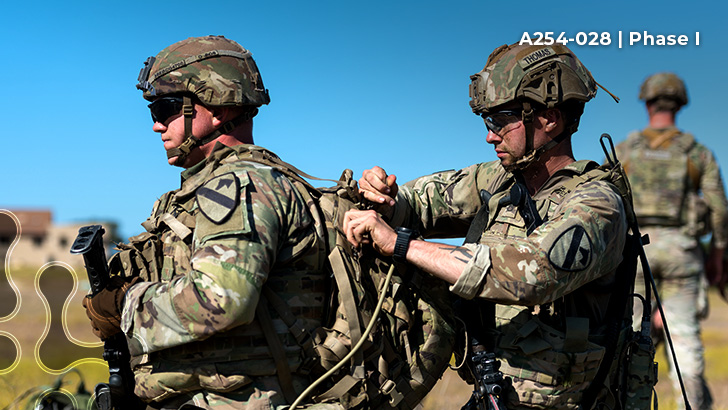

Objective
The goal of this topic is to develop a safe, stable, high-capacity, rechargeable, fiber-based structural battery that can be woven into the fabric of equipment worn by Soldiers and provide a power source for their electronic systems.
Description
On the modern battlefield, the combat load of a dismounted Soldier can exceed 100lbs on average. Often, 1/10 of that combat load is simply the batteries to power all their equipment. Mass proliferation of Soldier carried/worn equipment requires an equal or greater number of batteries to power the equipment for the duration of the mission.
In order to reduce the load carried by a Soldier while still maintaining adequate power for the Soldier’s electronic systems, the Army desires a rechargeable, fiber-based structural battery system that can be woven into the assault pack or rucksack of the Soldier, as well as other areas of the Soldier’s equipment loadout. By off-loading the power capacity to a fiber-based battery system in the Soldier’s pack and other carried equipment, the weight burden on the Soldier will be greatly reduced while maintaining operational efficiency.
Phase I
This topic is accepting Phase I proposals for a cost up to $250,000 for a 6-month period of performance. Development of an integrated rechargeable fiber-based battery into military end-item equipment. This can take the form of portions of the rucksack or other fabric-based equipment.
Phase II
Development of a stable, safe, high-power, rechargeable fiber-based battery compatible with current Army power connector types, embedded into specific substrates used in military clothing and individual equipment. Power capacity required should match or exceed the current capacity of the Conformal/Rigid Wearable Battery system (125 Wh/kg). The battery system should not add unnecessary weight or size to the Ruck or Assault pack.
Phase III
Any business involved in the electronic industry would greatly benefit from the innovations developed under this STTR. Industrial uses in vehicles would also benefit from technology developed under this STTR.
Submission Information
For more information, and to submit your full proposal package, visit the DSIP Portal.
SBIR|STTR Help Desk: usarmy.sbirsttr@army.mil
View the Component Instructions here.

References:
Objective
The goal of this topic is to develop a safe, stable, high-capacity, rechargeable, fiber-based structural battery that can be woven into the fabric of equipment worn by Soldiers and provide a power source for their electronic systems.
Description
On the modern battlefield, the combat load of a dismounted Soldier can exceed 100lbs on average. Often, 1/10 of that combat load is simply the batteries to power all their equipment. Mass proliferation of Soldier carried/worn equipment requires an equal or greater number of batteries to power the equipment for the duration of the mission.
In order to reduce the load carried by a Soldier while still maintaining adequate power for the Soldier’s electronic systems, the Army desires a rechargeable, fiber-based structural battery system that can be woven into the assault pack or rucksack of the Soldier, as well as other areas of the Soldier’s equipment loadout. By off-loading the power capacity to a fiber-based battery system in the Soldier’s pack and other carried equipment, the weight burden on the Soldier will be greatly reduced while maintaining operational efficiency.
Phase I
This topic is accepting Phase I proposals for a cost up to $250,000 for a 6-month period of performance. Development of an integrated rechargeable fiber-based battery into military end-item equipment. This can take the form of portions of the rucksack or other fabric-based equipment.
Phase II
Development of a stable, safe, high-power, rechargeable fiber-based battery compatible with current Army power connector types, embedded into specific substrates used in military clothing and individual equipment. Power capacity required should match or exceed the current capacity of the Conformal/Rigid Wearable Battery system (125 Wh/kg). The battery system should not add unnecessary weight or size to the Ruck or Assault pack.
Phase III
Any business involved in the electronic industry would greatly benefit from the innovations developed under this STTR. Industrial uses in vehicles would also benefit from technology developed under this STTR.
Submission Information
For more information, and to submit your full proposal package, visit the DSIP Portal.
SBIR|STTR Help Desk: usarmy.sbirsttr@army.mil
View the Component Instructions here.
References:
